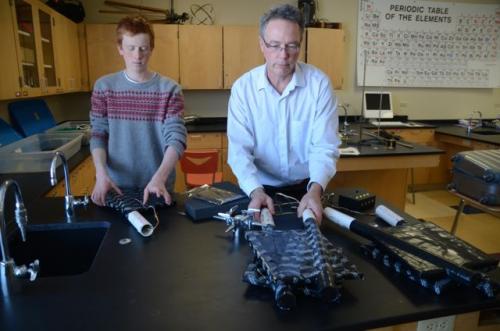Last thursday Jim Madsen, from IceCube, came to our school to help teach us more about the cosmic ray detectors and how they work. And help was what we definitely needed. The whole set up consisted of:
- 5 paddles
- 2 voltage distribution boxes
- 2 circuit boards
- 1 laptop
- 4 black cords
- GPSA Global Positioning System (GPS) is a satellite-based navigation system used to track the location or position of objects on the Earth’s surface. box
- GPSA Global Positioning System (GPS) is a satellite-based navigation system used to track the location or position of objects on the Earth’s surface. antenna
- temperature and barometric pressure probe
- black cord, green cord,white cord
- power source from a wall outlet
Here is quick video of the detector with Claire and Jim.
http://
All these components had to be carefully connected for the detector to work. The finished product looked like a tangle of wires and strange paddle looking things all connected in different spots. Many of the wires connected to a circuit board and than to a laptop. Once the setup had been completed we had to run a special program on the laptop that organized the data from the circuit board. The program counted how many particles each paddle was detecting. Our first order of operation was to ensure the detectors were working at their optimal level. To find out the optimal level for each of the detectors we had to slowly change the amount of voltage for each of the detectors. We would first record the initial count than the final count of each detector. Than we graphed the data on to excel. We looked for plateau's in the data. These are areas where the count rate of particles remained relatively constant, or their optimal levels. We had to continue this process for all four detectors.

It was important for us to find this information out because when we are in Antarctica we will need to be able to set up the detectors and get the best data possible.
Nos reunimos en la escuela con Jim Madsen, del proyecto IceCube, el pasado jueves. Vino para enseñarnos sobre le funcionamiento del detector de rayos cósmicos. Ayuda es lo que más necesitábamos. El detector está compuesto por:
- 4 paletas más una de repuesto
- 1 caja distribuidora de voltaje
- 1 tableta de circuitos
- 1 computadora portátil
- 4 cables negros
- 1 caja del GOS
- 1 antena del GOS
- Sensores de temperatura y presión atmosférica
- cables negros, verdes, blancos
- Fuente de voltaje que se conecta a la pared
Aquí un vídeo rápido del detector con Claire y Jim.
http://
Es necesario conectar todos estos componentes con mucho cuidado para que funcione el detector. El producto final parece una madeja de cables y paletas extrañas. Muchos de los cables se conectan a la tableta de circuitos y después a la computadora. Una vez montado el instrumental es necesario correr un programa especial en la computadora para organizar los datos que envía la tableta de circuitos. El programa cuenta cuántas partículas recibe cada paleta.
Lo primero que hicimos es asegurarnos que los detectores trabajan al nivel óptimo. Para encontrar este nivel óptimo, tuvimos que cambiar lentamente el voltaje para cada detector. Primero registramos el número inicial de partículas recibidas y el número final para cada voltaje. Después hicimos una gráfica en Excel, para encontrar dónde se presenta una meseta en los datos. El nivel óptimo se encuentra en las áreas donde el conteo de partículas se mantiene relativamente constante. Tuvimos que hacer esto para los cuatro detectores.

Es importante obtener toda esta información ya que cuando estemos en la Antártida podremos montar los detectores y obtener los mejores datos posibles.


Comments